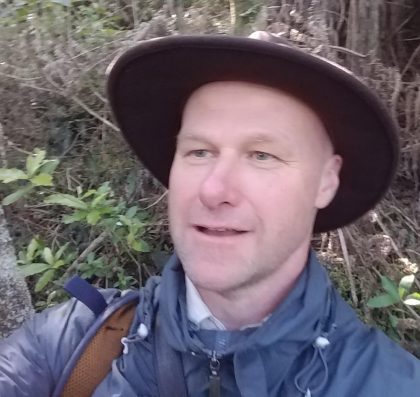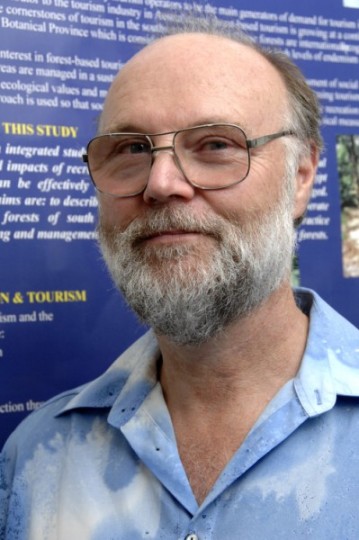More TBA soon
Jennifer Waithman

Wide Bay Burnett Environment Council Coordinator
Jennifer’s love and passion for natural resources has led her to spending over 20 years within the interpretation profession. She has worked for various federal, state and local governmental agencies in the United States and Australia including the U.S. Forest Service, National Park Service, U.S. Fish and Wildlife Service, the Nevada Department of Wildlife, Parks VIC and Sunshine Coast Council. Her professional journey has led to expertise in implementation of interpretation strategies/plans, development of interpretive exhibitions and trail signage, interpretive media and face-to-face program design and delivery. She is a Certified Interpretive Guide and Certified Interpretive Guide Trainer with the National Association for Interpretation (NAI-USA) and currently an Interpretation Australia General Executive Member.
———————————————————-
Jonathon Spring (Dr.), Steenwijk, Overijssel, Netherlands, Auckland Institute of Studies, Tourism and Hospitality Programme, Auckland, New Zealand.
Jonathon now lives in the Netherlands but will bee joining us online for an interactive presentation,
E-mail: springjonathon@gmail.com ORCID: 0000-0001-9211-0589
Biography

A guided encounter with New Zealand’s last remaining native owl, the Morepork, or Ruru (Ninox novaeseelandiae) in 2003 was a pivotal moment for my ability to think more deeply about my own relationship with wildlife and our natural environment. I had often heard but never remember seeing a Morepork until I participated in a guided performance at Auckland Zoo, Auckland, New Zealand. The show involved an owl flying around the audience in search for food and the audience was informed about how to get involved with community-based conservation. Subsequently, I became a volunteer with the ‘Ark in the Park’ project, a mainland sanctuary in a regional Auckland park, that sought to restore the native ecology through pest management and translocations. In 2005 as a volunteer for ‘Ark in the Park’ I saw a Morepork roosting during the day. I was off the track with a team monitoring poison-bait stations set up to control introduced pest predator species.
This volunteer work with Ark in the Park encouraged me to visit other protected areas where I could see New Zealand native birds. I participated in a guided tour on Tiritiri Matangi Open Scientific Reserve (Tiri), Hauraki Gulf, Auckland. The guide told us that she was a member of Supporters of Tiritri Matangi who organised the tours and helped manage the island. She said that we could join up and become guides like her. So, I did. In 2006, as a volunteer guide on Tiri, a juvenile Morepork could be seen from a vantage point on the track.
The enthusiasm and knowledge of guides for our wildlife and special places got me involved in work that allowed me to learn more about our World and the other animals we share it with. With the ever-increasing demand for recreational activities in protected areas such as our regional and national parks I am interested in finding ways to use guiding (face-to-face interpretation) to get visitors to appreciate and value ecological restoration work. My PhD study was on guide-visitor interaction during wildlife tours conducted by the Supporters of Tiritiri Matangi in New Zealand and Pacific Whale Foundation in Maui, Hawai’i.
Research Outputs
Orams, M, Forestell, P, & Spring, J. (2014). What’s in it for the whales? Exploring the contribution of environmental interpretation to conservation. In J. Higham, L. Bejder & R. Williams (Eds.). Whale-watching: Sustainable management and ecological management (pp. 146-62). Cambridge, England: Cambridge University Press.
Spring, J. (2023). Nature-based tourism and guided wildlife tours: designing wildlife tour experiences that optimise sustainable learning opportunities. Journal of Ecotourism, 22(1), 187-207. [This one is especially relevant to Jonathon’s presentation this year]
Spring, J. (2019). Learning during wildlife tours in protected areas: Towards a better understanding of the nature of social relations in guided tours. Journal of Tourismology, 5(1), 51‒71. https://doi.org/10.26650/jot.2019.5.1.0003
Spring, J. (2018). Learning during guided wildlife tours in protected areas and its implications for behavioural change and stewardship. In J. Dehez (Ed.). 9th International Conference on Monitoring and Management of Visitors in Recreational and Protected Areas (MMV) Abstract Book. Bordeaux, France: IRSTEA
Spring, J. (2017). Making sense of the experience: The role of guide visitor interaction during a guided wildlife tour (PhD thesis). AUT University, Auckland, New Zealand. Available at http://hdl.handle.net/10292/10837
Spring, J. (2015). Caught in the crossfire: Using participant observation to research guided tours. In M. Lück, J. Velvin, & B. Eisenstein (Eds.) The social side of tourism: The interface between tourism, society, and the environment (pp. 127-140). Frankfurt, Germany: Peter Lang Verlag.
Spring, J. and Losekoot, E.(2018). A time and place for Kaitiakitanga and Manākītanga in New Zealand’s tourism product. Paper presented at the 8th Biennial CRIE Conference: Online Learning in International Education (15-16 January), Auckland, New Zealand.
Contributions to study and industry
Spring, J. (2018). The craft of guiding: face-to-face interpretation workshop. Full day Interpretation Network New Zealand (INNZ). Workshops presented at Pukeiti, Taranaki Regional Council, Taranaki. (12 May)
Spring, J. (2018). Learning and reinforcement on SOTM guided tours. Talk presented at Supporters of Tiritiri Matangi (SoTM) Tiri Guiding Talks, Unitech, Auckland, April 23.
Spring, J. (2017). The power of face-to-face interpretation. In Perspectives on engagement – a panel discussion. INNZ Professional Development Workshop 2017, Hamilton Gardens, Hamilton, 13-15 September.
Spring. J. (2016). Book review: Tour guiding research: Insights, issues and implications, Annals of Leisure Research, 19(2), 263-265, DOI: 10.1080/11745398.2015.1093951
Spring, J. (2016).Sustainable wildlife tours and the concept of awareness. National Association of Interpreters International Conference, Wellington, 3 – 7 April.
Spring, J & Burns, L (2018) (Christchurch City Council) Workshops for Interpretation Network New Zealand (INNZ) at Wenderholm, Auckland, 10 – 11 March.
Spring, J., & Taumoepeau, S. (2017). Tonga Tourism Tour guiding workshop 3-7 April,
———————————————————-
NOTE: regrettably David is no longer able to join us. At the time of the conference he’ll be flying home from the Galapagos.
Prof David Newsome
Murdoch University
Presentation: A handful of sand, what looks like dead scrub and what? No elephants!

David Newsome, Emeritus Associate Professor
Environmental and Conservation Sciences, Murdoch University, Perth, WA
David’s interests focus on nature-based tourism with a particular emphasis on the environmental impacts of recreation and tourism, the sustainability of tourism in national parks and nature reserves, evaluation of the quality of ecotourism operations, geological tourism and wildlife tourism. David is a member of the IUCN World Commission on Protected Areas and Shark Bay World Heritage Advisory Committee. He has a particular interest in undertaking projects that will aid in the development of sustainable tourism in the Asian region. His publications include more than 150 journal articles, book chapters and reports. Substantial contributions include the books Natural Area Tourism: ecology, impacts and management and Wildlife Tourism. David is also co-editor of four books covering tourism where the focus is on geology and landscape.
https://scholar.google.com.au/citations?user=PQ2HunsAAAAJ&hl=en
Jennifer Waithman
Wide Bay Burnett Environment Council Coordinator
Jennifer’s love and passion for natural resources has led her to spending over 20 years within the interpretation profession. She has worked for various federal, state and local governmental agencies in the United States and Australia including the U.S. Forest Service, National Park Service, U.S. Fish and Wildlife Service, the Nevada Department of Wildlife, Parks VIC and Sunshine Coast Council. Her professional journey has led to expertise in implementation of interpretation strategies/plans, development of interpretive exhibitions and trail signage, interpretive media and face-to-face program design and delivery. She is a Certified Interpretive Guide and Certified Interpretive Guide Trainer with the National Association for Interpretation (NAI-USA) and currently an Interpretation Australia General Executive Member.
